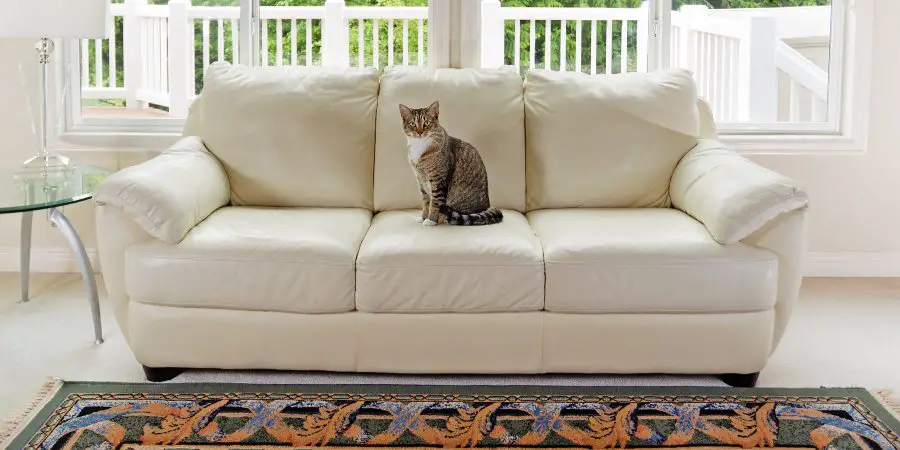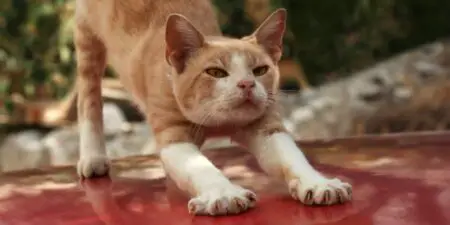When you first bring a cat into the house, it always wants to get on the furniture. This is because it has an instinct to be higher than everyone else and doesn’t know you yet. Outdoors, its place in the pecking order was obvious: there were all these other cats around, who would tell it where to go and what to do. Indoors, it’s all very confusing. Treat the problem firmly but gently. Just make it clear that this is not acceptable behavior.
Cats can also be very persistent and even manipulative; they learn from experience that specific actions lead to certain results from humans and repeat those actions. Trying to train a cat not to jump on your furniture is often less successful than you would like. If you try to train your cat by punishing him every time he jumps on the sofa, he may avoid the furniture when you’re around but will jump up as soon as you leave the room. Below are some ways to keep them off your furniture;
Aluminum Foil
The aluminum foil trick works. If you want to keep cats off the furniture, especially the nice upholstered furniture that they sometimes pee on, and even more significantly in winter when they like to lie in front of the warm air registers, then get aluminum foil. Tape it to the arms of your chair so that if a cat jumps up, it will be forced to stand on tippy toes or risk losing its balance and falling over.
The result is that they can’t stay there very long, and they don’t like it. If you have only one chair or sofa that needs protecting, just put a sheet of aluminum foil underneath it. If you have several problem chairs or sofas, cover them all.
Squirt Bottle
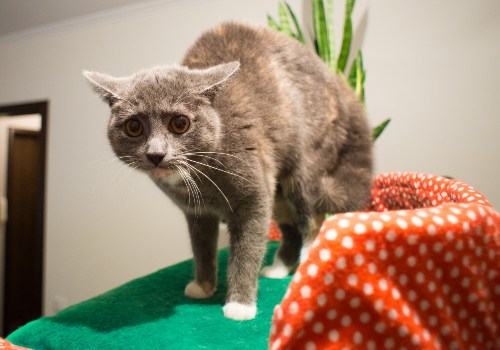
Cats, like most animals, hate being wet. As a result, squirting a cat with water is one of the surest ways to make it stop doing whatever you do not want it to do. If you want your cat to stay off the furniture, ask your veterinarian or a pet-store employee for advice on a spray bottle that delivers a fine mist. If you’re spraying outdoors and concerned about chemicals in the water, make your mix by adding several drops of liquid soap to water and shake well before using.
The best time to squirt the cat is right after it jumps up on the furniture. This way, it associates its punishment with whatever it is doing. After this association has been established, cats are smart enough to forget it if you need to remind them again later: Any time you see them thinking about jumping on the furniture, give them another squirt.
Plastic Carpeting
Cats like to be up high. The higher, the better. If you want to keep a cat from jumping on your furniture, at least 6 inches of plastic carpeting should do the trick. Tape the carpet down, preferably with double-sided tape so it will stay in place, and cut out a doorway for yourself. Cats don’t like walking on this stuff, so it will deter them from jumping up there in pursuit of your attention.
You may also want to invest in plastic carpet runners designed for high-traffic areas such as hallways and stairs. These are more expensive than furniture, but they won’t wear out as quickly. Plastic doesn’t have to be ugly or uncomfortable. It is available in colors and designs that mimic wood or tile flooring; if you are concerned about aesthetics or don’t have an aversion to picking up fur off your floors; these may be worth looking into.
Scratching Posts
[amazon bestseller=”cat Scratching Posts”]
A person must make sure that the cat has a scratching post. If it doesn’t, invest in one as soon as you can afford it. Most cats prefer scratching posts to furniture, and they can be trained to use them. Scratching posts come in all sizes and shapes, and some are more expensive than others. They are not meant to look pretty; instead, they are designed to meet your cat’s needs. Look for one that is sturdy and tall enough so that your cat can stretch out on it comfortably instead of furniture around the house.
Place scratching posts near the areas where the cat likes to hang out and near windows where he likes to sunbathe-a scratching post by a window often makes an excellent perch for watching birds and other outdoor activities.
Make Some Noise
Cats are smart. They know that you will make a lot of noise if they mess with the furniture, and they don’t want that. Cats do not like to draw attention to themselves, so they avoid making a fuss. Using this fact to keep cats off the furniture is simple. All you need to do is make more noise than your cat can stand. When your cat starts trying to get on the furniture, start making as much commotion as possible.
Yell at it, throw things, set off fireworks, or swing a baseball bat near it. Or stomp around and shout, “No!” You’ll be amazed at how fast your cat gives up and goes away. However, this strategy only works if you follow through every time your cat gets on the furniture. If you let it get away with even one misdeed, it won’t be afraid of getting caught anymore and will start doing whatever it was again.
Move Furniture Around
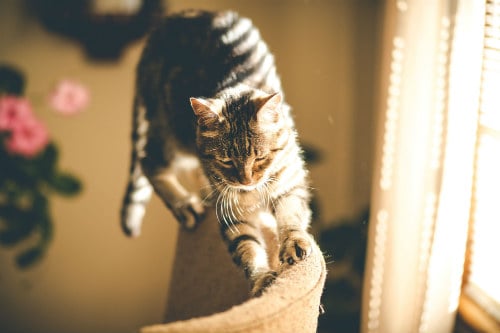
Cats like a routine, so they aren’t as likely to use it if you change how the furniture is arranged. If you don’t mind moving all of your furniture every time you want to keep cats off the furniture, then this is a great solution!
One way to deter your cat from jumping on the furniture is to move your furniture away from the wall so that they can’t leap onto it from the side or put a baby gate in the doorways to limit access. This will force them to leap from in front of you, and in turn, you can catch them in the act of jumping up.
Cat Perches and Towers
[amazon bestseller=”cat tower”]
A cat tower or perch might be just what a cat needs to avoid the furniture. You can place one in a room with high-value couches or chairs so that your cat has an appropriate place to scratch and jump — instead of your new white couch. Towers should be tall enough for cats to stretch while standing up and have sturdy platforms so they can climb to the top safely.
Perches come in all shapes and sizes, from simple spindly things to elaborate towers with multiple levels. You can build one yourself, but if you’re short on time or carpentry skills, you can buy a version at most pet supply stores. Add a comfy bed at the top, along with toys, to encourage your cats to use it. If your cat is declawed, make sure you place the tower in an area where she won’t be tempted to jump down without jumping first. Otherwise, it could end up hurting itself.
Citrus Peel
Cats dislike citrus peel. It’s a safe, non-toxic way to keep cats off the furniture. A baggie of citrus peel next to your chair keeps the cat from jumping up on it. Just don’t forget where the peel is. Just sprinkle citrus peel around areas where you don’t want the cat to go.
This is a good use for used orange peels, as well as small pieces of whole fruit you’ve finished eating. Alternatively, you can purchase orange peels from grocery stores. They will eventually get bored with the smell and distance themselves from those areas.
Toys
Toys are another good way to get your cat off the furniture. Cats are loving and playful creatures, but they can be a bit destructive. They like to play and want attention, so play with your cat frequently and give them toys to chase and bat around.
If you often play with your cat, they will be less likely to want to climb on the furniture, as they will not see it as their best place to play anymore. . This will also help keep it busy while you are gone or have company over so she doesn’t try to “help” by jumping on tabletops or other items in your home.
Cat Repellent
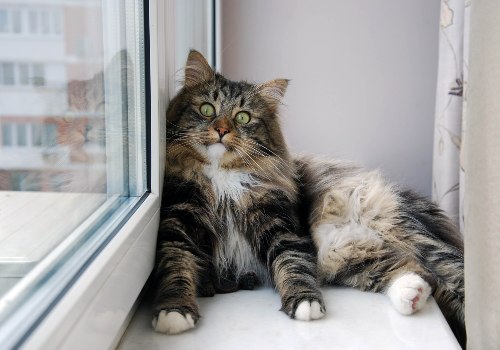
Cat repellent contains a product designed to make the furniture smell like natural predators. It works by spraying it directly on the fabric and leaving it for about 15 minutes. The cat will not want to come near the furniture after spraying it with the repellent because it smells like its predators.
The scent is not harmful to your pet, and it will fade away in time. However, some cat repellents are not very effective, so you’ll need to look for a worthwhile one.
Food
The key to keeping cats off furniture is to make sure they don’t associate the furniture with food. If you feed your cat on the couch or the bed, you will only learn that it’s a good place to eat. That will make it harder to get it off in the future. If you never feed them on the furniture, they won’t view it as their own. Instead, make sure your cat associates feeding time with his food bowl.
Summary
More than any other part of your home, the furniture is where you spend your time relaxing. While it’s nice to have your cat nearby, perhaps on a lap or at least in the room with you, it can be equally frustrating to have your cat scratching up or chewing on that expensive couch. You don’t have to resort to physical force. With the right strategy and a little patience, you should be able to keep your cat off of the furniture with minimal effort.
Can You Set Limits with Your Cat (Video)
"In ancient times cats were worshipped as gods; they have not forgotten this."
-- Terry Pratchett

